Abortion in Pigs母猪流产
妊娠母猪流产的原因分析及防控

2019年第7期 吉林畜牧兽医·养猪专栏·YangZhu ZhuanLan妊娠母猪流产的原因分析及防控肖 英湖南省祁东县畜牧水产局,湖南祁东 421600流产就是妊娠的中断,在妊娠母猪生产中表现为一种常见病症,可发生在妊娠母猪的不同阶段。
1 妊娠母猪流产的原因分析妊娠中断称之为流产,流产对母猪本身来说影响非常大,它有可能会导致母猪日后受孕困难,或者不受孕。
如果流产严重的话还会引起大出血导致母猪的死亡,以下是妊娠母猪流产的常见原因。
1.1 妊娠母猪的饲料质量处于妊娠期的母猪根据膘型的不同,应该制定出科学合理的饲料,但是有些养殖户不懂得营养搭配,造成妊娠母猪缺乏大量的蛋白质、维生素E以及钙、磷等微量元素,导致妊娠母猪没有充足的营养来供给自身和胎儿的生长发育,造成流产,还有不懂得科学搭配大量添加以上营养物质,使得能量水平过高也可能引发妊娠终止。
还有养殖户粗心将发霉的饲料投喂给妊娠的母猪,造成母猪代谢障碍导致流产。
1.2 疾病导致流产对于有过流产经历的母猪,当母猪自身还没有恢复健康的时候,尤其是子宫内环境伴有炎症时,这时母猪的再次受孕直接影响了日后胎儿的发育情况,胎儿在这种子宫环境下发育缓慢,严重的会直接造成流产。
1.3 应激反应导致流产在我国很多地区的养殖猪舍设施简单,空气流通性不好,这种情况下如果在遇到高温或者阴雨潮湿的季节时,妊娠的母猪会出现呼吸困难,情绪躁动不安,这对妊娠母猪的危害巨大,频繁的宫缩会导致缺氧、死胎最终流产。
还有在放养猪的过程中,饲养者大声喊叫,或者妊娠母猪和猪群一起杂乱无序,互相拥挤都有可能引发母猪受到惊吓,导致流产。
1.4 感染寄生虫和传染病导致流产由于母猪妊娠过程中自身免疫力有所下降,这时候如果猪舍消毒不彻底或者外来人员把传染病带进猪舍内,这时母猪最容易感染各种传染病和寄生虫,再加上疫苗接种的不及时或者根本没有接种疫苗都有可能促使母猪感染各类病毒,常见的发生在妊娠母猪身上并且会引发流产传染病有以下三种:第一种,猪瘟会导致胎儿垂直感染,轻者仔猪能够出生但是体质瘦弱,重者直接导致胎死腹中或直接流产。
母猪疾病流产如何防控措施及原因
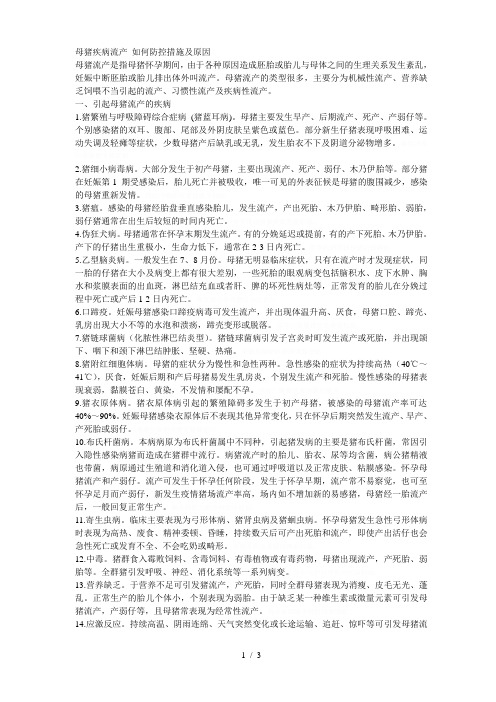
母猪疾病流产如何防控措施及原因母猪流产是指母猪怀孕期间,由于各种原因造成胚胎或胎儿与母体之间的生理关系发生紊乱,妊娠中断胚胎或胎儿排出体外叫流产。
母猪流产的类型很多,主要分为机械性流产、营养缺乏饲喂不当引起的流产、习惯性流产及疾病性流产。
一、引起母猪流产的疾病1.猪繁殖与呼吸障碍综合症病(猪蓝耳病)。
母猪主要发生早产、后期流产、死产、产弱仔等。
个别感染猪的双耳、腹部、尾部及外阴皮肤呈紫色或蓝色。
部分新生仔猪表现呼吸困难、运动失调及轻瘫等症状,少数母猪产后缺乳或无乳,发生胎衣不下及阴道分泌物增多。
2.猪细小病毒病。
大部分发生于初产母猪,主要出现流产、死产、弱仔、木乃伊胎等。
部分猪在妊娠第1 期受感染后,胎儿死亡并被吸收,唯一可见的外表征候是母猪的腹围减少,感染的母猪重新发情。
3.猪瘟。
感染的母猪经胎盘垂直感染胎儿,发生流产,产出死胎、木乃伊胎、畸形胎、弱胎,弱仔猪通常在出生后较短的时间内死亡。
4.伪狂犬病。
母猪通常在怀孕末期发生流产。
有的分娩延迟或提前,有的产下死胎、木乃伊胎。
产下的仔猪出生重极小,生命力低下,通常在2-3日内死亡。
5.乙型脑炎病。
一般发生在7、8月份。
母猪无明显临床症状,只有在流产时才发现症状,同一胎的仔猪在大小及病变上都有很大差别,一些死胎的眼观病变包括脑积水、皮下水肿、胸水和浆膜表面的出血斑,淋巴结充血或者肝、脾的坏死性病灶等,正常发育的胎儿在分娩过程中死亡或产后1-2日内死亡。
6.口蹄疫。
妊娠母猪感染口蹄疫病毒可发生流产,并出现体温升高、厌食,母猪口腔、蹄壳、乳房出现大小不等的水泡和溃疡,蹄壳变形或脱落。
7.猪链球菌病(化脓性淋巴结炎型)。
猪链球菌病引发子宫炎时町发生流产或死胎,并出现颌下、咽下和颈下淋巴结肿胀、坚硬、热痛。
8.猪附红细胞体病。
母猪的症状分为慢性和急性两种。
急性感染的症状为持续高热(40℃~41℃),厌食,妊娠后期和产后母猪易发生乳房炎,个别发生流产和死胎。
猪病查询-流产

06
相关资源和参考文献
相关数据库和网站
中国畜牧兽医数据库
提供猪病诊断、防治方面的信息及相关的研究资料。
中国畜牧信息网
包含猪病防治、饲养管理、市场行情等方面的信息。
农业部兽医局网站
发布猪病疫情、防治措施及兽药监管等方面的官方信息。
相关研究和论文
猪流产相关基因的研究
01
研究猪流产相关基因的表达和调控机制,为预防和治疗猪流产
临床症状
母猪表现腹痛、不安 、拱腰、努责,阴门 流出分泌物等。
若子宫内残留有死胎 或弱胎,可能引起子 宫炎、不孕症等问题 。
死胎或弱胎被排出时 ,母猪可能表现虚弱 、贫血、无食欲等症 状。
流行病学特点
流产可以发生在任何年龄和品种的母猪中,但初产母猪和老龄母猪更容易发生。 流产的发生可能与遗传因素、饲养管理、环境条件、疾病感染等多种因素有关。
某些传染病如猪瘟、猪蓝耳病、猪细小病毒病等可以引起流产。
02
病因分析
遗传因素
品种遗传性
不同品种猪的流产风险存在差异,有些品种具有较高的遗传易感性。
基因突变
某些基因突变可能增加流产的风险。
饲养管理问题
01
02
03
营养不足
饲料中营养不足,如缺乏 某些维生素、矿物质或蛋 白质,可能影响胎儿发育 导致流产。
定期检查
定期对猪只进行检查,发 现异常及时处理,防止病 情恶化。
饲养管理和环境优化
饲养环境
保持猪舍适宜的温度、湿度和 光照,减少应激因素对猪只的
影响。
饲料管理
保证饲料质量、充足供应,避免猪 只因营养不良或饥饿导致流产。
饮水管理
保证水源清洁、充足供应,避免猪 只因饮水不足或水质不良导致流产 。
最新 母猪流产的原因及防治措施-精品

母猪流产的原因及防治措施母猪流产.又称母猪妊娠中断.在母猪繁殖障碍中属于常见疾病,指在母猪怀孕期间.由各种原因导致胚胎或者母体的生理机能紊乱.造成妊娠中断出现胚胎死亡被母体吸收、浸溶、木乃伊胎、死胎以及早产儿或弱胎的现象。
母猪流产可发生在怀孕的任意阶段.防控难度很大。
母猪发生流产,会大大降低生产母猪利用率,降低母猪平均年产仔窝数.增加母猪空怀时间,进而形成成本的浪费。
而且母猪流产不仅造成胎儿夭折或者发育不良.若处理不当还会引起继发感染.损害母猪健康,严重者甚至会危及母猪生命。
因此,母猪流产会给养猪业造成巨大的经济损失.应该引起广泛重视。
1 母猪流产类型根据母猪流产发生时间、原因和临床症状不同,可大致分为隐性流产、小产、早产和延期流产等四种类型。
1.1隐性流产指胚胎液化被母体吸收.这种流产发生在母猪妊娠早期.很多没有特定临床症状,生产管理中不易被发现。
发生原因可能是染色体畸变、母体子宫内环境发生变化、近亲交配、营养原因以及公猪精液质量等。
1.2小产指在妊娠期间.母猪无任何征兆地排出未经变化的死胎.这种流产通常发生在妊娠中期和中后期。
引起母猪小产的因素很多,需要根据实际情况进行分析判断。
1.3早产指母猪在没有到预产期的情况下排出不足月胎儿,这种流产多发生于妊娠后期。
南于胎猪器官发育不完全,生命力较弱,很难存活下来。
发生原因主要有营养物缺乏、饲料发霉变质、乱用抗生素以及猪舍环境条件差等。
1.4延期流产指母猪在妊娠期间,胎儿在子宫中死亡,但因母猪子宫颈张开幅度小或子宫阵缩力小.死胎留滞在子宫内,发生三种变化:胎儿浸溶、胎儿腐败或胎儿十尸化.外观上以死胎和木乃伊胎较常见。
母猪的流产
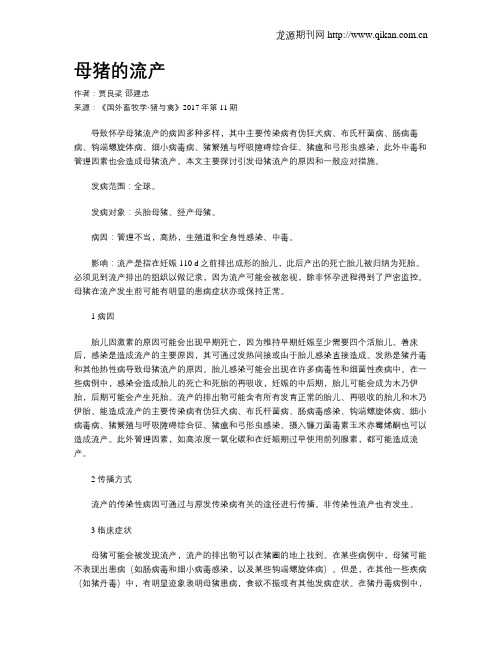
母猪的流产作者:贾良梁邵建忠来源:《国外畜牧学·猪与禽》2017年第11期导致怀孕母猪流产的病因多种多样,其中主要传染病有伪狂犬病、布氏杆菌病、肠病毒病、钩端螺旋体病、细小病毒病、猪繁殖与呼吸障碍综合征、猪瘟和弓形虫感染,此外中毒和管理因素也会造成母猪流产。
本文主要探讨引发母猪流产的原因和一般应对措施。
发病范围:全球。
发病对象:头胎母猪、经产母猪。
病因:管理不当,高热,生殖道和全身性感染、中毒。
影响:流产是指在妊娠110 d之前排出成形的胎儿,此后产出的死亡胎儿被归纳为死胎。
必须见到流产排出的组织以做记录,因为流产可能会被忽视,除非怀孕进程得到了严密监控。
母猪在流产发生前可能有明显的患病症状亦或保持正常。
1 病因胎儿因激素的原因可能会出现早期死亡,因为维持早期妊娠至少需要四个活胎儿。
着床后,感染是造成流产的主要原因,其可通过发热间接或由于胎儿感染直接造成。
发热是猪丹毒和其他热性病导致母猪流产的原因。
胎儿感染可能会出现在许多病毒性和细菌性疾病中。
在一些病例中,感染会造成胎儿的死亡和死胎的再吸收,妊娠的中后期,胎儿可能会成为木乃伊胎,后期可能会产生死胎。
流产的排出物可能含有所有发育正常的胎儿、再吸收的胎儿和木乃伊胎。
能造成流产的主要传染病有伪狂犬病、布氏杆菌病、肠病毒感染、钩端螺旋体病、细小病毒病、猪繁殖与呼吸障碍综合征、猪瘟和弓形虫感染。
摄入镰刀菌毒素玉米赤霉烯酮也可以造成流产。
此外管理因素,如高浓度一氧化碳和在妊娠期过早使用前列腺素,都可能造成流产。
2 传播方式流产的传染性病因可通过与原发传染病有关的途径进行传播。
非传染性流产也有发生。
3 临床症状母猪可能会被发现流产,流产的排出物可以在猪圈的地上找到。
在某些病例中,母猪可能不表现出患病(如肠病毒和细小病毒感染,以及某些钩端螺旋体病)。
但是,在其他一些疾病(如猪丹毒)中,有明显迹象表明母猪患病,食欲不振或有其他发病症状。
在猪丹毒病例中,母猪通常出现高热和特征性的皮肤损伤。
猪流产的防治措施

2021年第3期 吉林畜牧兽医·养猪专栏·YangZhu ZhuanLan猪流产的防治措施李向军吉林省东丰县拉拉河镇综合服务中心,吉林东丰 136300母猪在妊娠过程中由于饲养管理、营养、药物等方面而发生流产,导致直接的经济损失,需要加强饲养和技术人员的责任心, 应用科学技术,科学管理、营养科学搭配等生产措施,不断提高更加科学的母猪生产管理技术。
1 猪流产的病因分析猪流产是一种危害性极大的疾病,其不仅会导致胎儿夭折或者是发育不良,同时还会对母体造成较大的损害,严重时甚至会使得母猪不育。
导致猪流产的原因相对来说比较复杂,其主要集中在以下方面。
1.1 母猪妊娠期间,饲养管理不当母猪在妊娠期间,饲养管理不当,饲料的配比不够科学合理,饲料中蛋白质、维生素和矿物质等成分缺乏,母猪孕期无法有效摄入相关营养元素。
1.2 母猪孕期营养过剩母猪在孕期营养过剩,过于肥胖,子宫内沉淀的脂肪比较多,脂肪对子宫产生了压迫,造成供血不足,或者是子宫无法跟随胎儿的生长发育而扩张,因此限定了胎儿的生长发育。
同时,母猪长期缺乏正常生长所需要的各类营养物质,机体过于瘦弱,摄入营养物质,无法维持胎儿的正常发育,也可能会导致流产。
1.3 近亲繁殖近亲繁殖,公猪和母猪为直系亲属,因此胚胎成活率大幅度下降。
1.4 饲料供给不稳定饲料供给不稳定,没有根据母猪孕期需要定时定量供给,或者是在母猪孕期频繁更换饲料,饲料的质量比较差。
1.5 妊娠期母猪混合饲养妊娠期将大批量母猪混合饲养,饲养密度大,饲养环境差,因此母猪出现了相互挤压、撕咬以及争食等现象。
此外,如果猪舍的环境状况不理想,母猪在孕期长期睡在阴冷、潮湿的垫草上面,也会增加流产发生率。
1.6 母猪孕期感染部分母猪在孕期感染了猪瘟、猪丹毒、流感、肺炎等疾病。
或者是由于饲养管理不当,导致母猪出现霉菌中毒、棉籽饼中毒、菜籽饼中毒等症状,也将会引发流产。
1.7 母猪孕期药物滥用母猪在孕期药物滥用,如服用过量的泻剂、利尿剂等药物。
浅谈母猪流产原因及防治措施

浅谈母猪流产原因及防治措施云南省曲靖市,654214前言:母猪产仔数直接影响到养猪户的经济效益,防止母猪流产是提高母猪繁殖能力,降低饲养成本的重要举措,通常情况下母猪的流产率是2%,但对养猪业带来的损失和威胁却是较严重的。
流产,不仅使胎儿天折,而且损害母猪健康,导致不育,严重的还会危及母猪生命或过早淘汰。
降低了母猪的繁殖能力,增加了养猪成本,直接影响了养殖增收。
本文详细叙述病毒性疾病原因及综合防治措施。
一、母猪流产的主要表现形式1.已形成的胚胎或尚未成形的胎体的流产,常被误以为是配而未孕。
2.配种后20d以内的流产见不到胎儿流出,母猪往往表现出不规律的再发情。
3. 30多天的流产也只见像胎衣一样的东西流出,而且很少带血丝,只有怀孕时间相对长的流产,才能见到胚胎。
所以,可将流产归纳为两种,一种是看得见胎儿的流产,另一种是看不见胎儿的流产。
引起母猪流产的病因较多且复杂,最常见的有病毒性、细菌性、寄生虫性、霉菌毒素、营养性疾病引起的流产。
中毒性疾病、机械性损伤等也能引起母猪流。
二、导致母猪的流产的常见病1.猪繁殖与综合征病理特征:PRRSV感染后所产仔猪和胎儿很少有特征性病变,致死的胎儿病变是子宫内无菌性自溶的结果;流产的胎儿血管周围出现以巨噬细胞和淋巴细胞浸润为特征的动脉炎、心肌炎和脑炎。
鼻甲部黏膜的病变是感染后期的特征,其上皮细胞纤毛脱落,上皮内空泡形成和黏膜下层淋巴细胞、巨噬细胞和浆细胞浸润。
血管、神经系统、生殖系统的病变主要表现为淋巴、巨噬细胞、浆细胞的增生和浸润。
临床症状:本病的临诊症状变化很大,且受病毒株、免疫状态及饲养管理因素和环境条件的影响。
低毒株可引起猪群无临诊症状的流行,而强毒株能够引起严重的临诊疾病。
发病母猪主要表现为精神沉郁、食欲减少或废绝、发热,出现不同程度的呼吸困难,妊娠后期(105~107天),母猪发生流产、早产、死胎、木乃伊胎、弱仔。
母猪流产率可达50%~70%,死产率可达35%以上,部分新生仔猪表现呼吸困难,运动失调及轻瘫等症状。
规模化猪场母猪流产的原因与对策

所谓母猪流产,即妊娠中断,是指母猪在怀孕期间,由于各种原因造成胚胎或胎儿与母体之间的生理关系发生紊乱,妊娠不能继续而中断。
妊娠中断后胚胎或胎儿会发生不同的变化,如胚胎液化被母体吸收,胎儿干尸化,胎儿浸溶,死胎被排出体外或活胎被排出体外。
一、母猪流产的表现形式1.早产。
其临产预兆和产程与正常分娩相似,胎儿是活的,但未足月即提早产出,因怀孕时间短,胎儿生命力较弱,如能做好保温、协助吮乳或人工喂乳尚可存活。
2.死胎。
(1)胎儿已死,但未发生变化。
这时,死亡胎儿对母体而言已是异物,引起子宫收缩,数天后连同胞衣一起产出。
(2)胎儿干尸化,又称“木乃伊”。
胎儿死后,因子宫颈口闭锁,加之子宫收缩很微弱,死胎仍存在于与空气隔绝、又无细菌、无病毒、无其他微生物的子宫腔内,胎儿与胞衣的水分被子宫吸收,体积缩小而干硬,胞衣又紧裹胎儿体表,呈“纸质样”,致干硬缩小的死胎成为黑色,到分娩时,随同正常胎儿一起产出。
(3)胎儿浸溶。
胎儿死于子宫内,由于子宫颈口已张开,非腐败性微生物进入子宫内,侵入死胎体内,使死胎软组织液化分解被排出母体外,余下的骨骼仍残存于子宫内,引起母猪发病:体温升高,厌食、腹泻、阴道经常流出恶臭的脓性液体及小骨片。
如不及时清除子宫内残存的胎儿骨骼和脓汁,将引起广泛的子宫炎,甚至导致败血症死亡。
(4)胎儿腐败气肿。
胎儿死于子宫内,子宫颈口已张开,腐败菌侵入,使胎儿发生腐败性分解。
此时母猪体温升高,不食、沉郁、呻吟不安,频频努责等症状,如不及时救治,也易引起败血症死亡。
二、母猪流产的原因1.管理因素。
(1)圈舍性流产。
当前,规模化猪场的圈舍大多房顶较矮,坐北朝南,单列式或双列式结构,可保冬暖,但夏不凉,适合养本地猪种,而不适合养外国品种猪。
在每年高温季节,部分母猪难耐高温高湿而流产。
(2)饲养性流产。
是指饲料品质不良或饲喂方法不当,如饲喂发霉变质饲料、含有农药、灭鼠药、有毒植物、亚硝酸盐的饲料以及喂给煮马铃薯的水(含龙葵甙)等,均可造成流产。
母猪流产的原因与防控
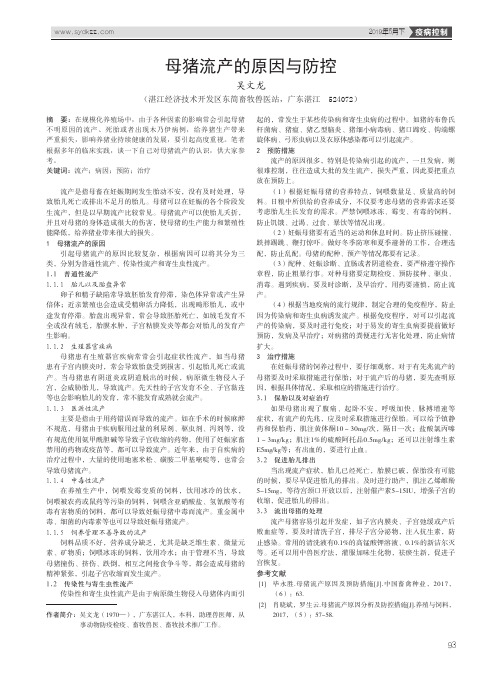
摘 要:在规模化养殖场中,由于各种因素的影响常会引起母猪不明原因的流产、死胎或者出现木乃伊病例,给养猪生产带来严重损失,影响养猪业持续健康的发展,要引起高度重视。
笔者根据多年的临床实践,谈一下自己对母猪流产的认识,供大家参考。
关键词:流产;病因;预防;治疗流产是指母畜在妊娠期间发生胎动不安,没有及时处理,导致胎儿死亡或排出不足月的胎儿。
母猪可以在妊娠的各个阶段发生流产,但是以早期流产比较常见。
母猪流产可以使胎儿夭折,并且对母猪的身体造成很大的伤害,使母猪的生产能力和繁殖性能降低,给养猪业带来很大的损失。
1 母猪流产的原因引起母猪流产的原因比较复杂,根据病因可以将其分为三类,分别为普通性流产、传染性流产和寄生虫性流产。
1.1 普通性流产1.1.1 胎儿以及胎盘异常卵子和精子缺陷常导致胚胎发育停滞,染色体异常或产生异倍体;近亲繁殖也会造成受精卵活力降低,出现畸形胎儿,或中途发育停滞。
胎盘出现异常,常会导致胚胎死亡,如绒毛发育不全或没有绒毛,胎膜水肿,子宫粘膜发炎等都会对胎儿的发育产生影响。
1.1.2 生殖器官疾病母猪患有生殖器官疾病常常会引起症状性流产,如当母猪患有子宫内膜炎时,常会导致胎盘受到损害,引起胎儿死亡或流产。
当母猪患有阴道炎或阴道脱出的时候,病原微生物侵入子宫,会威胁胎儿,导致流产。
先天性的子宫发育不全、子宫黏连等也会影响胎儿的发育,常不能发育成熟就会流产。
1.1.3 医源性流产主要是指由于用药错误而导致的流产。
如在手术的时候麻醉不规范,母猪由于疾病服用过量的利尿剂、驱虫剂、泻剂等,没有规范使用氨甲酰胆碱等导致子宫收缩的药物,使用了妊娠家畜禁用的药物或疫苗等,都可以导致流产。
近年来,由于自疾病的治疗过程中,大量的使用地塞米松、磺胺二甲基嘧啶等,也常会导致母猪流产。
1.1.4 中毒性流产在养殖生产中,饲喂发霉变质的饲料,饮用冰冷的饮水,饲喂被农药或鼠药等污染的饲料,饲喂含亚硝酸盐、氢氰酸等有毒有害物质的饲料,都可以导致妊娠母猪中毒而流产。
母猪流产发病原因与防治
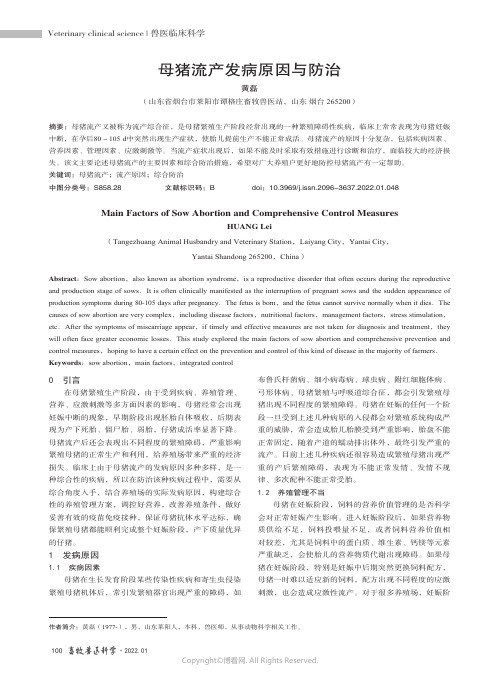
Veterinary clinical science | 兽医临床科学100 ·2022.010 引言在母猪繁殖生产阶段,由于受到疾病、养殖管理、营养、应激刺激等多方面因素的影响,母猪经常会出现妊娠中断的现象,早期阶段出现胚胎自体吸收,后期表现为产下死胎、僵尸胎、弱胎,仔猪成活率显著下降。
母猪流产后还会表现出不同程度的繁殖障碍,严重影响繁殖母猪的正常生产和利用,给养殖场带来严重的经济损失。
临床上由于母猪流产的发病原因多种多样,是一种综合性的疾病,所以在防治该种疾病过程中,需要从综合角度入手,结合养殖场的实际发病原因,构建综合性的养殖管理方案,调控好营养,改善养殖条件,做好妥善有效的疫苗免疫接种,保证母猪抗体水平达标,确保繁殖母猪都能顺利完成整个妊娠阶段,产下质量优异的仔猪。
1 发病原因1.1 疾病因素母猪在生长发育阶段某些传染性疾病和寄生虫侵染繁殖母猪机体后,常引发繁殖器官出现严重的障碍,如布鲁氏杆菌病、细小病毒病、球虫病、附红细胞体病、弓形体病、母猪繁殖与呼吸道综合征,都会引发繁殖母猪出现不同程度的繁殖障碍。
母猪在妊娠的任何一个阶段一旦受到上述几种病原的入侵都会对繁殖系统构成严重的威胁,常会造成胎儿胎膜受到严重影响,胎盘不能正常固定,随着产道的蠕动排出体外,最终引发严重的流产。
目前上述几种疾病还很容易造成繁殖母猪出现严重的产后繁殖障碍,表现为不能正常发情、发情不规律、多次配种不能正常受胎。
1.2 养殖管理不当母猪在妊娠阶段,饲料的营养价值管理的是否科学会对正常妊娠产生影响。
进入妊娠阶段后,如果营养物质供给不足,饲料投喂量不足,或者饲料营养价值相对较差,尤其是饲料中的蛋白质、维生素、钙镁等元素严重缺乏,会使胎儿的营养物质代谢出现障碍。
如果母猪在妊娠阶段,特别是妊娠中后期突然更换饲料配方,母猪一时难以适应新的饲料,配方出现不同程度的应激刺激,也会造成应激性流产。
对于很多养殖场,妊娠阶作者简介:黄磊(1977-),男,山东莱阳人,本科,兽医师,从事动物科学相关工作。
母猪流产的原因分析及防控措施

养殖与饲料2017年第1期摘要母猪流产是养猪生产中一种常见的疾病,直接影响养猪生产。
本文对母猪各种流产的原因、症状、治疗和防控措施进行总结。
关键词母猪;流产;原因;防控措施母猪流产的原因分析及防控措施汤喜林辽宁省北票市动物疫病预防控制中心,辽宁北票122100收稿日期:2016-11-05汤喜林,男,1974年生,高级兽医师。
母猪流产是指母猪未到预产时间而产出胎儿,并且胎儿无生活能力。
怀孕期间,由于各种原因造成妊娠中断,妊娠中断后胚胎或胎儿会发生不同变化。
母猪流产的类型很多,主要分为非传染性流产、传染性流产和寄生虫性流产、疾病性流产。
引起流产的原因一般分为传染性和非传染性(饲养和管理)因素,怀孕的每个阶段都可发生流产,一般怀孕早期较多。
根据临床症状,可以做出诊断。
要判定是否为传染性流产则需进行实验室检查。
1流产病因1)饲料品质不佳,饲喂量不足或营养成分不全。
其中饲料霉变是引起流产最常见的原因。
2)管理不当导致流产,例如怀孕母猪与其它猪打斗或被野蛮驱赶、打伤、撞伤、挤伤,均可诱发子宫收缩而引起流产。
3)发情鉴定不准确,例如母猪本已怀孕而被误认为空怀,强行配种或人工授精,往往可引起流产。
4)母猪生殖器官病变可造成流产。
例如,患局限性慢性子宫内膜炎可导致胎儿死亡或流产。
5)胎儿及胎盘发育异常。
胎膜水肿、胎盘上的绒毛变性、胎水过多等疾病,可影响胎儿的生长发育或导致胎儿死亡而流产。
6)生殖激素失调。
当激素作用紊乱时,子宫的机能活动和内环境变化不能适应胚胎发育的需要,胚胎发育会受到影响或出现早期死亡。
7)猪体温升高、呼吸困难、高度贫血等,均可能发生流产。
猪的妊娠毒血症等也会发生流产。
2临床症状有的配种后半个月妊娠不明显,随着发情时排出的黏液一起排出胎儿,不容易被发现。
排出不足月胎儿时,其征兆和正常分娩相似,但不像正常分娩那样明显,仅在排出胎儿前2~3d 乳房突然膨大,阴唇稍微肿胀,乳头可挤出清亮的液体,从阴门排出清亮的黏液。
论述母猪流产的原因及防治措施

状可分为约四种类型的隐性流产,小分娩, 也影响荷尔蒙分泌。这导致黄体酮和黄体
$"& 繁殖技术因素
早产和延迟流产。这是胚胎被基质燃烧和 酮的分泌。这会导致胎儿死亡。环境温度低
妊娠检测不足,母猪的假性皮疹和不
吸收的时候。在怀孕初期发生了流产。其中 也会对怀孕母猪产生负面影响。母猪堕胎。 正确的沉降判断可导致怀孕母猪流产。
每年的垃圾数量。增加母猪的空闲时间,从 严重受伤的猪仔儿出生不良,分娩后母猪 理怀孕后备母猪的饲料,添加足够的营养
而造成成本浪费。母猪流产不仅会导致胎 恢复正常。
儿流产或发育迟缓。如果处理不当,也可能
$、科学环境与饲料管理方式
导致继发感染。母猪健康受损,严重甚至会
$"! 科学使用药物
成分,这些成分有助于生殖功能,可以起作 用,易于分配并且具有更高的出生率。此 外,是否值得讨论汤姆的问题,保留母猪是
目前,我国大型猪场的母猪使用时间 变或染色体畸变。 结果导致胚胎或胎儿
须根据实际情况进行分析。
通常为 & 至 ' 年,每年的淘汰率约为 $%。 缺陷导致母猪流产。
!"$ 早产
母猪年龄较大,出现非喷发,非受孕或流产Βιβλιοθήκη $"( 母猪子宫内膜炎
母猪排出胎儿的时间少于几个月而未 等现象。如果繁殖为时过早,母猪就不会完
出生日期之前中止的胎儿通常是健康的胎
更重要,综合预防原则可以更容易地控制
儿,在不同时间段内相继死亡。 #"# 寄生虫病
母猪流产的发生。 (作者单位:!(&#)) 黑龙江省孙吴县
寄生虫病主要包括弓形体病、附红细
畜牧兽医局腰屯乡畜牧服务中心)
+ *% +
母猪流产怎么办母猪流传的主要因素和防治措施

母猪流产怎么办母猪流传的主要因素和防治措施母猪一年平均胎次大概在2.2流产六次可以说就损失了母猪一年肥猪近四成的生产力了。
不小这就很可怕对养猪场效益影响十分巨大。
而且猪不止是收益对母猪的伤害更深非常大。
没事还是好,出事的话轻则不育重则难产至死。
那么母猪流产怎么办?母猪流传的主要因素因素和防治措施。
引发母猪流产恶性肿瘤的病因非常复杂,主要风险因素可归结为三大类:营养类因素、病理类因素及外界烈性因素。
一、营养性因素1.饲粮变质:由于饲料中不足维生素、矿物质,或者饲料霉变、饲料营养密度科散囊所致。
临床上常见的为或霉菌毒素中毒导致的流产。
2.营养价值不全:饲粮中各营养价值不全面(特别是蛋白质、维生素E、钙、磷、镁的缺乏)以及给予霉败、有毒饲料而使并令胎儿营养物质代谢障碍而引发流产。
二、病理类因素(一)烈性传染病1.猪瘟(慢性型)妊娠母猪感染后,将病毒通过胎盘交与胎儿造成流产、产或产出弱小的仔猪或断奶后出现腹泻。
2.蓝耳病母猪流产多发生于妊娠中期、后期,可产死胎、木乃伊胎、弱仔。
产下的仔猪多站立不稳、无力嘶鸣,伴随腹泻、咳嗽等症状。
母猪流产怎么办?肉食流传的主要环境保护因素和防治措施3.口蹄疫妊娠母猪感染口蹄疫病毒可会发生流产,并出现体温升高、厌食,母猪口腔、蹄壳、乳房出现大小不等湿的水泡和溃疡,蹄壳变形或脱落。
4.猪链球菌病(化脓性淋巴结炎型)引发子宫炎时可时候发生流产或早产。
并出现颌下、咽下和颈下以淋巴结肿胀、坚硬、热痛。
5.猪附红细胞体病母猪的症状可叠成拆成慢性和急性两种。
急性感染的症状为持续高热(40℃~41℃),厌食,妊娠初期频发和产后母猪易发生乳房炎,个别母猪发生流产和死胎。
慢性感染的母猪整体表现衰弱,黏膜苍白、黄染,不发情和屡配不孕症。
(二)猪的繁殖障碍性疾病1.猪的伪狂犬病猪的伪狂犬病表现四大特征:①妊娠母猪发生胎死腹中、产死胎、木乃伊胎,以产死胎为主。
②引起螺科榧仔猪大量死亡,表现为刚生下来的仔猪第一天还好,从第二天开始肺癌,3~5天是死亡高峰期,有时整窝死光。
母猪流产如何防控疾病原因及措施
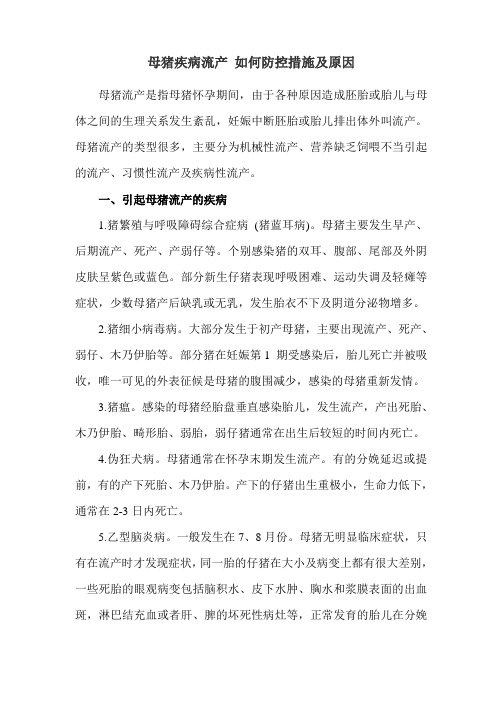
母猪疾病流产如何防控措施及原因母猪流产是指母猪怀孕期间,由于各种原因造成胚胎或胎儿与母体之间的生理关系发生紊乱,妊娠中断胚胎或胎儿排出体外叫流产。
母猪流产的类型很多,主要分为机械性流产、营养缺乏饲喂不当引起的流产、习惯性流产及疾病性流产。
一、引起母猪流产的疾病1.猪繁殖与呼吸障碍综合症病(猪蓝耳病)。
母猪主要发生早产、后期流产、死产、产弱仔等。
个别感染猪的双耳、腹部、尾部及外阴皮肤呈紫色或蓝色。
部分新生仔猪表现呼吸困难、运动失调及轻瘫等症状,少数母猪产后缺乳或无乳,发生胎衣不下及阴道分泌物增多。
2.猪细小病毒病。
大部分发生于初产母猪,主要出现流产、死产、弱仔、木乃伊胎等。
部分猪在妊娠第1 期受感染后,胎儿死亡并被吸收,唯一可见的外表征候是母猪的腹围减少,感染的母猪重新发情。
3.猪瘟。
感染的母猪经胎盘垂直感染胎儿,发生流产,产出死胎、木乃伊胎、畸形胎、弱胎,弱仔猪通常在出生后较短的时间内死亡。
4.伪狂犬病。
母猪通常在怀孕末期发生流产。
有的分娩延迟或提前,有的产下死胎、木乃伊胎。
产下的仔猪出生重极小,生命力低下,通常在2-3日内死亡。
5.乙型脑炎病。
一般发生在7、8月份。
母猪无明显临床症状,只有在流产时才发现症状,同一胎的仔猪在大小及病变上都有很大差别,一些死胎的眼观病变包括脑积水、皮下水肿、胸水和浆膜表面的出血斑,淋巴结充血或者肝、脾的坏死性病灶等,正常发育的胎儿在分娩过程中死亡或产后1-2日内死亡。
6.口蹄疫。
妊娠母猪感染口蹄疫病毒可发生流产,并出现体温升高、厌食,母猪口腔、蹄壳、乳房出现大小不等的水泡和溃疡,蹄壳变形或脱落。
7.猪链球菌病(化脓性淋巴结炎型)。
猪链球菌病引发子宫炎时町发生流产或死胎,并出现颌下、咽下和颈下淋巴结肿胀、坚硬、热痛。
8.猪附红细胞体病。
母猪的症状分为慢性和急性两种。
急性感染的症状为持续高热(40℃~41℃),厌食,妊娠后期和产后母猪易发生乳房炎,个别发生流产和死胎。
怀孕母猪发生流产、死胎的原因汇总

怀孕母猪发生流产、死胎的原因汇总养猪生产是一个动态和循环的过程,木乃伊在妊娠中后期形成、肉眼可见(在妊娠前期胚胎被机体吸收不可见),死胎则在临产前几天和分娩时产生,弱仔则涉及到几个阶段,如妊娠阶段、哺乳阶段、保育阶段都可以产生。
引起怀孕母猪发生流产、死胎、木乃伊、畸形仔、弱仔的疾病比较复杂,总体上可分为疾病、营养、环境、遗传等几方面因素。
一、疾病因素有了它,你还用去棋牌室嘛?广告1、病毒性疾病:(1)母猪无临床症状,可见木乃伊化、死胎、畸形仔、弱仔:①猪细小病毒(PPV):妊娠母猪感染细小病毒后,怀孕期间通常无任何临床症状,母猪所产健仔少,并娩出死胎、木乃伊胎和畸形仔等,母猪还出现发情期延长或不发情,多次配种不孕。
②猪乙型脑炎:妊娠母猪患病后,发生突然流产、死胎、木乃伊、弱胎、畸形胎,死胎皮下水肿,三腔积液,并有小出血点,肝、脾有坏死点(灶)。
③猪病毒性腹泻病毒:母猪流产,流产的胎儿无特异病变,但可能出现淋巴结出血和小脑发育不良。
④猪肠病毒感染、猪腺病毒感染、猪巨细胞病毒感染、猪其他病毒感染。
胎儿、胎盘不伴有其他特异性病变。
(2)母猪有临床症状,窝总仔少、木乃伊化,可产出死胎、弱仔:展开剩余74%①猪伪狂犬病:妊娠母猪患病后发生流产、死胎、木乃伊胎、弱胎等,可出现打喷嚏、咳嗽、可能呕吐等症状,胎儿的肝、脾出现灰白色坏死灶,并出现坏死性胎盘炎。
②猪瘟:妊娠母猪患病后,体温升高,伴有结膜炎、先便秘、后腹泻,呼吸困难,皮肤有出血点(斑),可发生流产、死胎、木乃伊、弱胎、畸形胎。
死胎头、嘴、四肢、背部、臀部和腹部均有不同程度出血点,脾稍肿大并有出血点,肾有出血点,头畸型,小脑发育异常。
(3)母猪有临床症状,可产出木乃伊、死胎、弱仔,但常处于同一胎龄。
猪繁殖与呼吸障碍综合症(蓝耳病)、变异蓝耳病:患病的妊娠母猪突然出现厌食、嗜眠和呼吸急促症状,发生流产、死胎、木乃伊胎和弱仔猪,死胎脐带坏死、动脉炎,产下的弱仔猪免疫抗病功能较差。
母猪流产的原因、临床症状及其防治

母猪流产的原因、临床症状及其防治作者:刘德胜来源:《现代畜牧科技》 2018年第5期摘要:母猪流产是一种常见病,是指妊娠过程的终止,临床上主要是出现早产(即产出未足月的活胎儿)或者产出死胎以及干尸化胎儿,通常是由于感染传染性病原微生物而导致。
该病会影响母猪身体健康,严重时会导致其无法受孕甚至发生死亡,严重影响规模化养猪的稳定发展,现概述该病的原因及防治措施。
关键词:母猪;流产;病因分析;临床症状;药物治疗;饲养管理;免疫预防中图分类号:S858. 28文献标识码:B文章编号:2095-9737(2018)05-0113-011 病因分析环境不良。
妊娠母猪长距离颠簸运输、强力捕捉、受到挤压以及发生跌倒等时,都能够导致胎儿发生机械性损伤而出现流产。
妊娠母猪受到过度惊吓、强烈噪声刺激会导致精神严重紧张,分泌较多的肾上腺素,会反射性地导致子宫收缩而发生流产。
舍内温度过低,供给冰水或者躯体用凉水冲洗,夏季没有采取有效的降温,以及舍内含有高水平氨气等,都有可能导致母猪出现流产。
饲养不当。
妊娠母猪摄取某些营养物质较少,如缺乏蛋白质、维生素E、钙、磷、镁等,或者食入发霉腐败、有毒的饲料,都会导致胎儿的营养物质代谢出现异常,从而引起母猪流产。
妊娠母猪采取不合理的饲喂方式,如饲喂含有亚硝酸盐、老鼠药、农药以及有毒植物的饲料,或者饲喂含有龙葵甙的马铃薯等,都能够使其发生流产。
传染性疾病。
即由于感染寄生虫和病原微生物而导致流产。
这类流产可分成两种类型,一种自发性流产,是母畜生殖器官、胎膜以及胎儿直接感染寄生虫或者病原微生物而引起,如衣原体病、布氏杆菌病等;另一种为症状性流产,是指患有某些寄生虫病和传染病后的一个症状为流产,如繁殖与呼吸综合征、伪狂犬病、钩端螺旋体病、弓形体病等。
用药不合理。
预防和治疗妊娠母猪疾病中使用的多种药物都可导致流产,部分药物能够在妊娠期间应用,但当剂量过大时就可能导致流产。
例如,服用大量的麻醉剂、利尿剂、泻药以及其他能够刺激子宫收缩的药物(如前列腺素F素、雌激素等),都能够导致流产;使用大剂量的糖皮质激素类药物,如地塞米松等,也能够导致流产,另外各种雌激素类药物还易于导致母猪妊娠中止或者假孕;抗蠕虫药物,如苯丙咪唑类药物(噻苯咪唑、丙硫咪唑、芬苯哒唑等),可能会导致畸形胎,从而中止妊娠,尤其是在受精后20~40天用药更容易发生;使用大剂量的血虫净(贝尼尔)也能够引起流产;大环内酯类药物,如果体重使用3 mg/kg以上,就可能导致妊娠后期母猪发生流产;阿散酸,如果在每千克饲料中添加250 mg以上,就会导致流产或则产死胎;妊娠期接种注射流感疫苗及其他病毒性疫苗,会导致妊娠后期母猪发生流产。
母猪流产管理制度

母猪流产管理制度一、前言母猪流产是养猪过程中常见的情况,流产对养猪场经济产生了不利影响。
流产不仅会导致母猪的生产力下降,还可能影响其他母猪的配种和生产。
因此,建立一套科学合理的母猪流产管理制度对于提高养猪场生产效率至关重要。
二、母猪流产的原因1. 饲养管理不当:饲养环境的恶劣、饲料的不合理等都会导致母猪产生压力和不适,进而引起流产。
2. 疾病感染:母猪在孕期受到各种疾病的侵害,如布氏杆菌病、伪狂犬病、猪链球菌感染等,都会导致母猪流产。
3. 遗传因素:母猪自身的遗传因素也可能导致流产。
4. 环境因素:恶劣的气候环境、过度的紧张情绪等都可能导致母猪流产。
5. 其他原因:还有一些其他原因可能导致母猪流产,包括意外伤害、配种问题等。
三、母猪流产管理制度的建立1. 定期体检:养猪场应定期对母猪进行体检,发现异常情况及时处理,减少流产的发生率。
定期体检的频率应根据品种、年龄和季节来确定,一般建议季度进行一次综合体检,发情期前后加强。
2. 保持良好的饲养环境:养猪场应保持良好的饲养环境,保持良好的卫生条件,保证养猪场内的通风和排水设施的畅通。
同时,应根据不同季节饲料的需要,合理安排喂养计划和饲料配比。
3. 合理配种:合理选择公猪与母猪的配种,避免过于近亲配种。
保证公猪的质量和健康,对母猪的体质、性情、生产性能等进行综合考虑,选择适宜的公猪进行配种。
4. 饲料管理:保证母猪的饲料营养平衡,保证饲料的卫生安全。
要根据母猪不同的生理时期,制定科学的饲养管理计划,确保母猪的营养需求。
5. 疾病预防:采取有效的疾病预防措施,对常见的猪流感、猪瘟、猪蓝耳病等进行预防控制。
定期对母猪进行疫苗接种,并加强养猪场的环境消毒。
6. 管理培训:培养养猪场员工的养猪管理技能,提高员工的养猪专业知识水平,增强员工的观察力和解决问题的能力。
四、母猪流产管理制度的执行1. 制定母猪流产管理计划:养猪场应根据实际情况制定母猪流产管理计划,并明确责任人和执行时间表。
母猪秋季流产
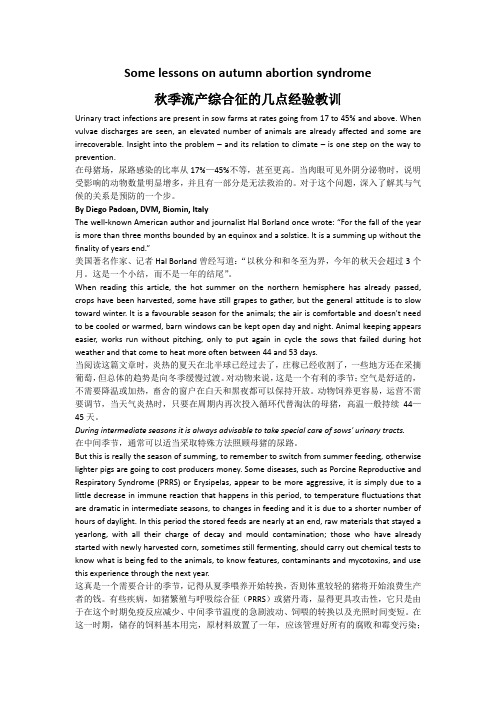
Some lessons on autumn abortion syndrome秋季流产综合征的几点经验教训Urinary tract infections are present in sow farms at rates going from 17 to 45% and above. When vulvae discharges are seen, an elevated number of animals are already affected and some are irrecoverable. Insight into the problem – and its relation to climate – is one step on the way to prevention.在母猪场,尿路感染的比率从17%—45%不等,甚至更高。
当肉眼可见外阴分泌物时,说明受影响的动物数量明显增多,并且有一部分是无法救治的。
对于这个问题,深入了解其与气候的关系是预防的一个步。
By Diego Padoan, DVM, Biomin, ItalyThe well-known American author and journalist Hal Borland once wrote: “For the fall of the year is more than three months bounded by an equinox and a solstice. It is a summing up without the finality of years e nd.”美国著名作家、记者Hal Borland曾经写道:“以秋分和和冬至为界,今年的秋天会超过3个月。
这是一个小结,而不是一年的结尾”。
When reading this article, the hot summer on the northern hemisphere has already passed, crops have been harvested, some have still grapes to gather, but the general attitude is to slow toward winter. It is a favourable season for the animals; the air is comfortable and doesn't need to be cooled or warmed, barn windows can be kept open day and night. Animal keeping appears easier, works run without pitching, only to put again in cycle the sows that failed during hot weather and that come to heat more often between 44 and 53 days.当阅读这篇文章时,炎热的夏天在北半球已经过去了,庄稼已经收割了,一些地方还在采摘葡萄,但总体的趋势是向冬季缓慢过渡。
- 1、下载文档前请自行甄别文档内容的完整性,平台不提供额外的编辑、内容补充、找答案等附加服务。
- 2、"仅部分预览"的文档,不可在线预览部分如存在完整性等问题,可反馈申请退款(可完整预览的文档不适用该条件!)。
- 3、如文档侵犯您的权益,请联系客服反馈,我们会尽快为您处理(人工客服工作时间:9:00-18:30)。
Abortion in PigsMany agents that cause reproductive failure in sows produce a broad spectrum of sequelae, including abortions and weak neonates, as well as stillbirth, mummification, embryonic death, and infertility. Mummification is seen more frequently in swine than in many other species due to the large litter size. If only a few fetuses die, abortion rarely occurs; instead, mummies are delivered at term, along with live piglets or stillbirths.NONINFECTIOUS CAUSESHigh ambient temperature (>32°C) is associated with increased returns to estrus, increased embryonic mortality, decreased farrowing rates, and small litters. The effect is greatest if heat stress occurs at the time of breeding or implantation. Increased embryonic mortality and increased irregular return to estrus are seen in pigs bred during the summer. High ambient temperature may play a role, but there is evidence that seasonal low progesterone levels are a major factor.The estrogenic mycotoxins zearalenone and zearalenol interfere with conception and implantation causing infertility, embryonic death, and reduced litter size, but rarely, if ever, abortion. Another class of mycotoxins, the fumonisins, causes acute pulmonary edema in swine; sows that recover from the acute disease often abort 2–3 days later.Other toxic causes of abortions or stillborn pigs include cresol sprays (used for mange and louse control), dicumarol, and nitrates. Nutritional causes of reproductive failure are not well defined. Vitamin A deficiency can cause congenital anomalies and possibly abortions. Riboflavin deficiency can cause early premature births (14–16 days), and calcium, iron, manganese, and iodine deficiencies have been associated with stillbirths and weak pigs.Carbon monoxide toxicity due to faulty propane heaters has been associated with increased numbers of stillbirths and autolyzed full-term fetuses. Fetal tissues are cherry red; the sows do not appear affected.INFECTIOUS CAUSESThe major infectious causes of reproductive failure in pigs include porcine reproductive and respiratory syndrome virus, porcine parvovirus, pseudorabies virus, Japanese B encephalitis virus, classical swine fever virus, Leptospira spp, and Brucella suis.Porcine Reproductive and Respiratory Syndrome (PRRS)PRRS is caused by an arterivirus. It is the most important disease of pigs in the USA and is of major importance throughout most of the world. Most PRRS strains do not cross the placenta until after 90 days of gestation. Consequently, most abortions are near the end of gestation. Affected litters contain fresh and autolyzed dead pigs, weak infected pigs, and healthy, uninfected pigs that often develop respiratory disease within a few days of birth. The sows are often anorectic and feverish a few days before aborting. Concurrent respiratory disease and increased numbers of bacterial infections in the herd are common. Hemorrhage in the umbilical cord, when present, is the only gross lesion associated with PRRS abortions. Not all fetuses are infected, so multiple fetuses should be sampled. Viral antigen is most consistently present in the fetal thymus and in fluid collected from the fetal thoracic cavity. PCR testing of pooled thoracic fluid from 3–5 fetuses is the most reliable means of diagnosis. Herd management is important in control and prevention. Inactivated and modified live virus vaccines are available. (see Porcine Reproductive and Respiratory Syndrome.)Porcine ParvovirusPorcine parvovirus is ubiquitous in pigs in the USA and most of the world. Almost all females are naturally infected before their second pregnancy, and immunity is lifelong. Consequently, it is a disease of first parity pigs. Fetal infection before 70 days of gestation can result in death of the fetus. Not all fetuses are infected at the same time, and death at different stages of pregnancy is typical. Some fetuses survive and are born alive but persistently infected. Most fetuses infected after 70 days of gestation mount an immune response, clear the virus, and are healthy at birth. Litters with dead fetuses of varying sizes, including mummified fetuses, along with stillborn and healthy pigs born to first parity gilts are the hallmark of porcine parvovirus. Diagnosis is by fluorescent antibody testing, virus isolation using lung from mummified fetuses, or demonstration of precolostral antibody in stillborn pigs. Boars shed virus by varying routes, including semen, for a couple of weeks after acute infection and can introduce the virus into a herd. Effective inactivated vaccines are available.Pseudorabies (Aujeszky's Disease, Porcine Herpesvirus 1 Infection)Pseudorabies is a cause of CNS and respiratory diseases. Infection results in latency, and seropositive animals are considered infected. Infection early in pregnancy can result in embryonic death and resorption of the fetuses. Infection later in pregnancy can result inabortion and birth of stillborn and weakpigs. Mummification can occur but is uncommon. There are no gross lesions in most aborted pigs, but a few have pinpoint white foci of necrosis in the liver and tonsils. Diagnosis is by virus isolation, PCR, or fluorescent antibody staining. Effective gene-deleted vaccines that allow serologic differentiation of vaccinated and naturally infected pigs were developed for the eradication program in the USA, but after eradication from commercial pigs was completed in 2003, vaccination was discontinued. Feral pigs in multiple states harbor the virus, and since 2003 there have been sporadic outbreaks of pseudorabies in herds that have contact with feral pigs. These outbreaks are currently controlled by herd depopulation. (see Pseudorabies.)Japanese B Encephalitis Virus InfectionJapanese B encephalitis is an arthropod-borne disease that causes reproductive failure in pigs and encephalitis in humans. Infected litters can contain dead pigs of various sizes (including mummies), stillborn pigs, weak pigs, and pigs with CNS signs. Hydrocephalus and subcutaneous edema are the most common gross lesions. Pigs are the primary amplifying host for the virus and are vaccinated not only to prevent reproductive failure, but also to prevent human infection.Classical Swine Fever (Hog Cholera)Classical swine fever is caused by a pestivirus that has been eradicated from the USA but is a serious problem throughout much of the world. With highly virulent strains that cause serious maternal illness, abortion is common. With strains of moderate or low virulence, birth of mummified and stillborn pigs, weak pigs, and persistently infected pigs are more common. Fluorescent antibody staining, virus isolation, and PCR are used for diagnosis. Both killed and modified live vaccines are available, but their use in the USA is prohibited. (see Classical Swine Fever.)Porcine Circovirus InfectionPorcine circovirus type 2 (PCV2) occurs worldwide, is ubiquitous in pigs, and is associated with several conditions, including sporadic outbreaks of late-term abortions and term litters with increased numbers of dead piglets. The dead piglets vary from small, mummified fetuses to stillbirths. Nonmummified fetuses typically have a large amount of serosanguinous fluid in their body cavities. Microscopically, there is myocardial necrosis and/or fibrosis, and PCV2 is present in the heart and other tissues. The incidence of PCV2 reproductive failure is very low; when it occurs the problem soon disappears, perhaps because most pigs are naturally exposed and immune prior to beingbred. Vaccines are available for grower and finisher pigs, but their efficacy in preventing reproductive failure is unknown.LeptospirosisLeptospira interrogans(especially serovar Pomona) is a major cause of reproductive failure in swine. Although acute leptospirosis occurs in adult swine, most cases are asymptomatic. Pigs infected with serovars Pomona and Bratislava can become chronic renal carriers. Abortion occurs 1–4 wk after infection, so the abortuses are autolyzed. Mummification, maceration, stillbirths, and weak pigs are also seen. Diagnosis is based on demonstration of leptospires in fetal tissues or stomach contents. Vaccination with a multivalent bacterin every 6 mo helps prevent the disease. Streptomycin was formerly used to eliminate the carrier state and to treat pregnant sows during an outbreak, but it is no longer available for use in food animals. Experimentally, high levels of injectable oxytetracycline, tylosin, and erythromycin and high levels of tetracyclines in the feed have eliminated the carrier state. However, field results indicate that Leptospira infection cannot be reliably eliminated with antibiotics. Leptospirosis is zoonotic. (see Leptospirosis.)BrucellosisBrucellosis (Brucella suis infection) in commercial swine has become rare in the USA as a result of state and federal control programs. However, it is present in feral pigs in multiple states; these represent a source of infection for commercial pigs and humans. Infected sows can abort at any stage of gestation, and abortions are not always accompanied by illness. Abortion is probably due to endometritis and fetal infection. There are few fetal or placental lesions, although some fetuses may be autolyzed. Diagnosis is by serology and isolation from the placenta and fetal tissues. No treatment has been uniformly effective. Control is based on test and slaughter. Brucellosis is one of the few venereal diseases recognized in swine. B suis causes a serious zoonotic disease. (see Brucellosis in Large Animals.)Other Infectious Causes of AbortionPigs with foot-and-mouth disease (see Foot-and-Mouth Disease), African swine fever (see African Swine Fever), and swine influenza (see Swine Influenza) often abort, but they and their herdmates also have clinical signs of those diseases. Enteroviruses and encephalomyocarditis virus have been reported to cause fetal losses in pigs, but they are not considered economically important. Blue eye paramyxovirus is an important cause of abortion, stillbirths, and mummified fetuses in parts of Mexico. Bacteria that cause sporadic abortionsinclude Staphylococcus aureus, Streptococcus spp, Erysipelothrix rhusiopathiae, Salmonella spp, Pasteurella multocida, Arcanobacterium pyogenes, Listeria monocytogenes, and Escherichia coli.。
